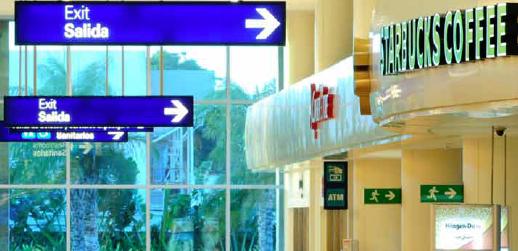
Privatization is often seen as a money-raising exercise by governments selling off national assets, but the experience in Mexico with airports run by Grupo Aeroportuario del Sureste (ASUR) shows that performance can be enhanced, as Alan Swaby learns.
Having just returned from a vacation in Italy, the timing to write about airport management couldn’t have been better. Once past security checks, the airport coffee and sandwich were very enjoyable. It’s just that the coffee had to be collected from different halves of the same concessionary—two lines plus a third line to pay, which, by the way, you do before ordering. No, it doesn’t make sense, but it’s what happens.
Then the only two flights leaving at that precise time of the day were arranged to embark from adjacent gates that shared the same access stairway. No, that doesn’t make sense either, but it’s what happened. The chaos getting through the various checkpoints or the 20-minute wait on the tarmac wisely won’t even be mentioned. And all this from a newly built terminal.
One thing is certain: the airport in question won’t be winning any accolades from Airports Council International (ACI), the Switzerland-based organization whose role it is to measure passenger satisfaction at 130 airports worldwide. The Mexican airport at Cancún, on the other hand, has just got a nice pat on the back: best airport in Latin America and third-best in the entire world. Not bad for a vacation airport with a geographical monopoly.
“We want our passengers to be happy,” says Adolfo Castro Rivas, CFO and strategic planning officer for Grupo Aeroportuario del Sureste (ASUR), the management company behind Cancún and eight other regional airports in the far south of Mexico. “When customers are happy, they spend money with the airport concession holders, and this makes more profit for us. It’s a win-win-win situation.”
If you had traveled to Cancún in the 1990s, you might have thought you were in Italy. At the time all Mexican airports were government controlled, and once having fulfilled their obligation of putting the buildings and runways in place, the bureaucrats running them quite frankly switched off. “There was no incentive to provide good service,” says Castro. “It didn’t make any difference whether the airports made money or not. Airport budgets were a function of the overall country’s economy.”
Ironically, change came about when the country ran out of cash. With more votes to be had by building hospitals rather than maintaining airports, matters just got worse until the point—10 years ago—when they went private. The country’s 35 airports were divided into four parcels and invitations to bid sent out to professional airport managers around the world. Copenhagen Airport, with three other international partners, formed the investment consortium ITA and won the bid for the smallest parcel of nine airports. ITA held 15 percent of the equity in ASUR, and the other 85 percent was sold on the stock exchange in two tranches.
With a business that had been starved of investments of any kind and manned by a workforce that couldn’t even be sure that ma┼êana was possible, ASUR had a job on its hands instilling the concept of service to those on the payroll. “Not only have we turned direct airport employees around,” says Castro, “but these days we also undertake to train—at our expense—anyone who works at any of the airport concession holders. But as the ACI survey demonstrates, it has more than paid off.”
ASUR’s contract with shops and food outlets operating within the terminal building is that they pay a nominal ground rent plus a percentage of their turnover or a fixed amount per passenger, whichever is greatest. As such, Castro knows down to the penny how much passengers are spending as they wait to fly home. He inherited a situation where the average spend was just $0.70 and has grown that to an average of $4.50. At the same time the number of passengers in Cancun Airport has increased from 7.1 million to 12.7 million. All this is reflected in the share price, which was $15 when first floated and is now $47.
ASUR has also put order into the way the airports are to develop. Previously they had grown wild, without plan, structure or direction. Each airport now has a master plan that maintains order and optimum traffic flow, now and into the rest of the 50-year franchise it holds. More than $500 million has been invested so far in bringing the airports into the 21st century.
The jewel in the group’s crown is Cancún, which handles around 450 flights a day compared with a total of 300 flights through the other eight airports. Of the 15 million passengers a year that ASUR handles, 13 million go to Cancún. Of these, 75 percent are international travelers, 75 percent of whom come from the United States—travelers not known for their quiet acceptance of shoddy service.
As we approach ASUR’s 10th anniversary, all its initial targets have long been met. A complete overhaul of all procedures has seen a transformation of how the business is run. Outside, safety-critical considerations were the first to be attended to. Runways, lighting, access and parking have all been given the treatment. To save airline operators money, time and distance spent taxiing have been reduced while schedules have been organized to minimize waiting time for planes. In no-frills fashion, ASUR’s airports can turn airplanes around in 20 minutes.
When passenger volumes look as though more than eight minutes will be spent in line, more staff are brought in and more lines opened. “And yet we have a total workforce of just 800,” says Castro, “including head-office personnel. It is done by good planning of multifunctional teams.”
It’s a good bet that the coffee in Cancún will never match that of the Italian airport, but in all other respects ASUR is showing many much longer established operations how things should be done. www.asur.com.mx













